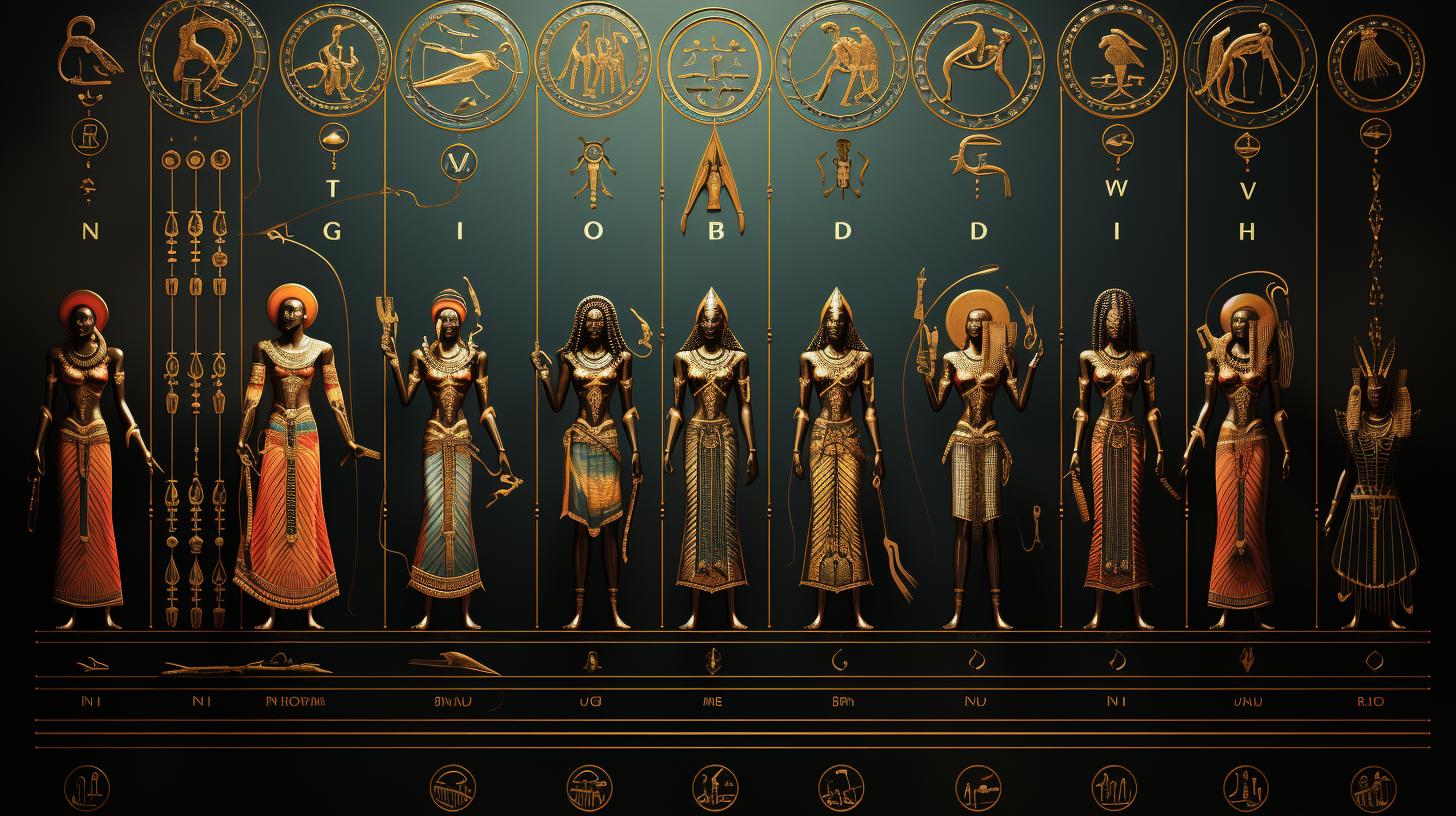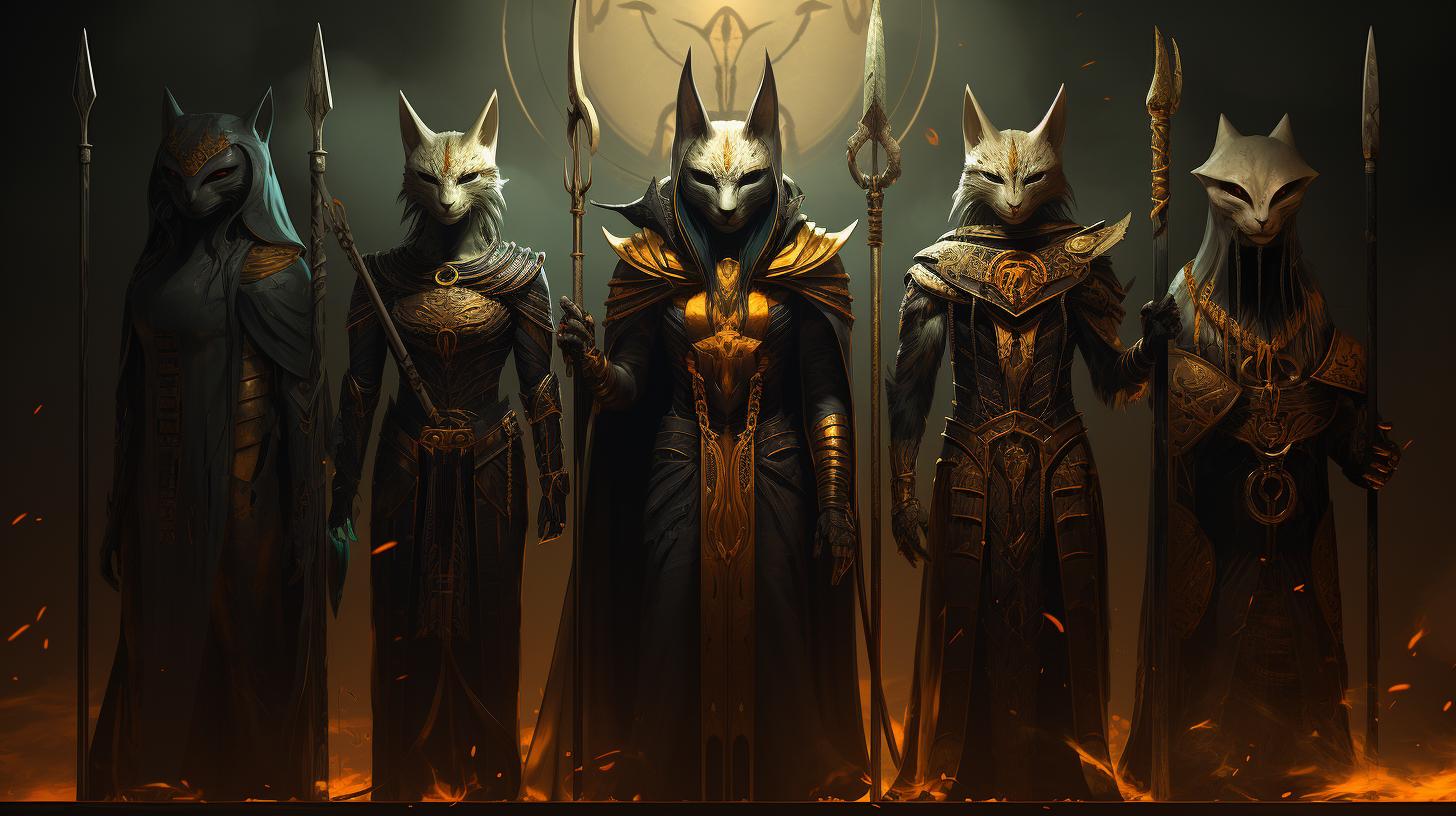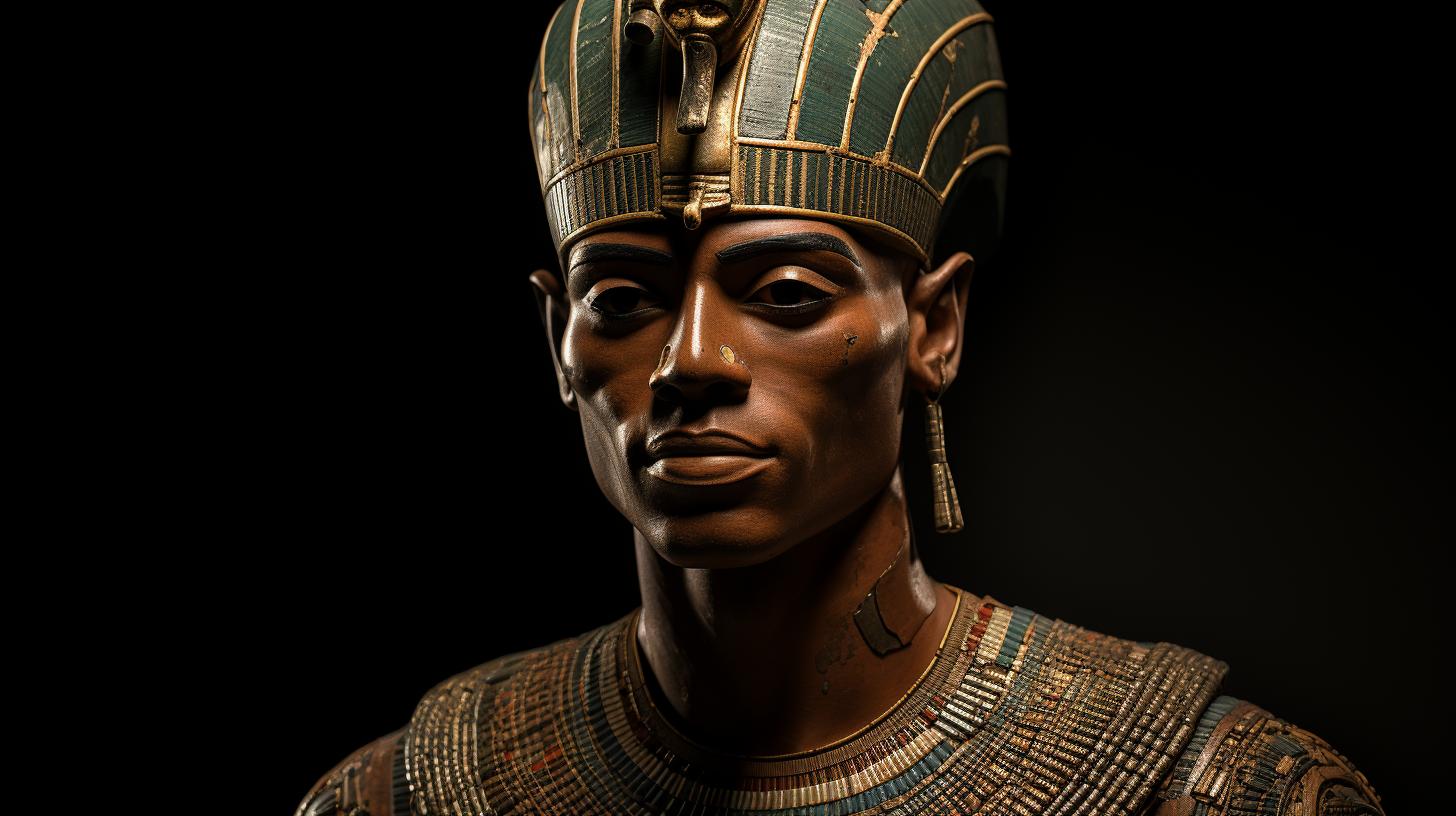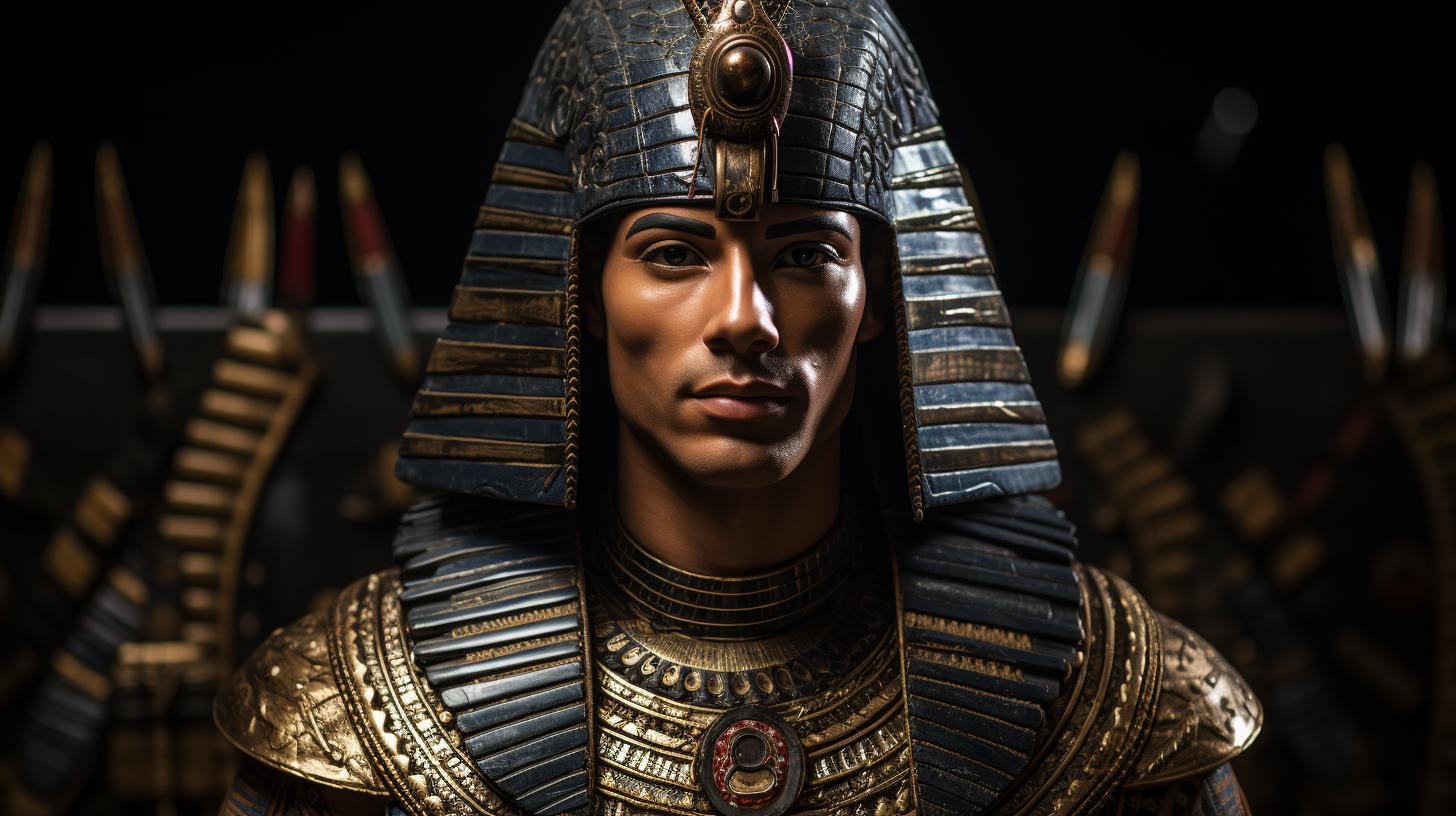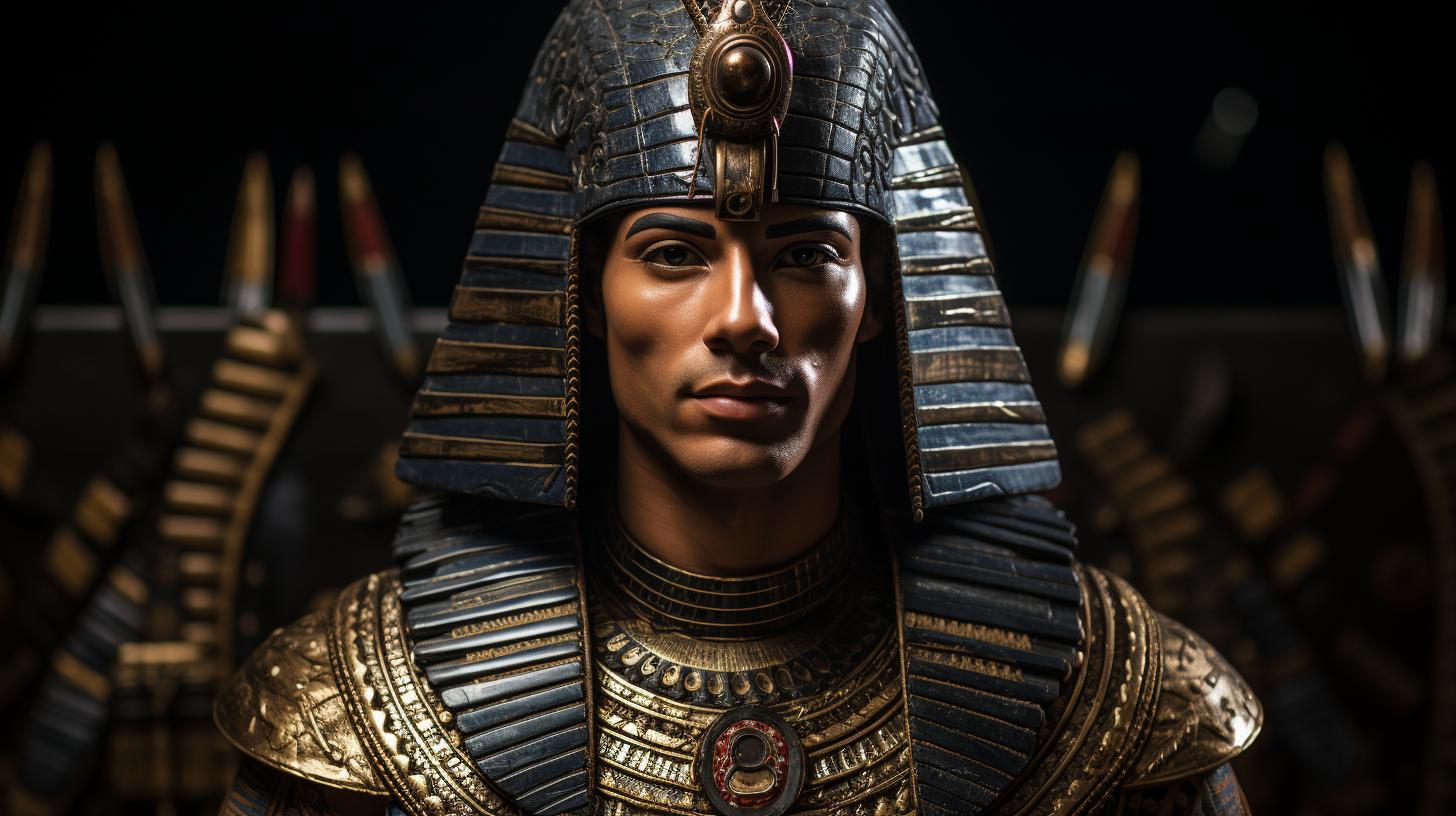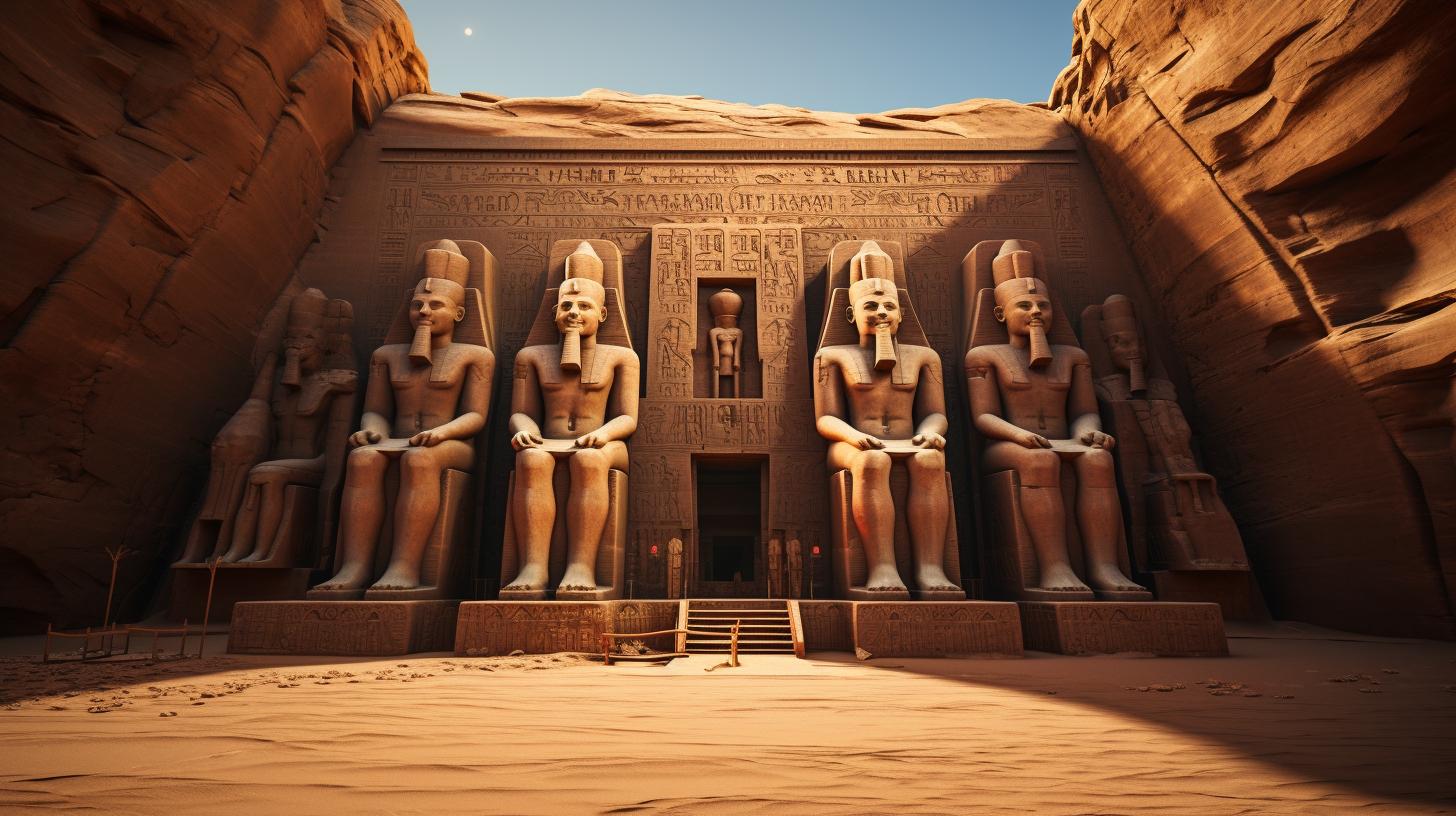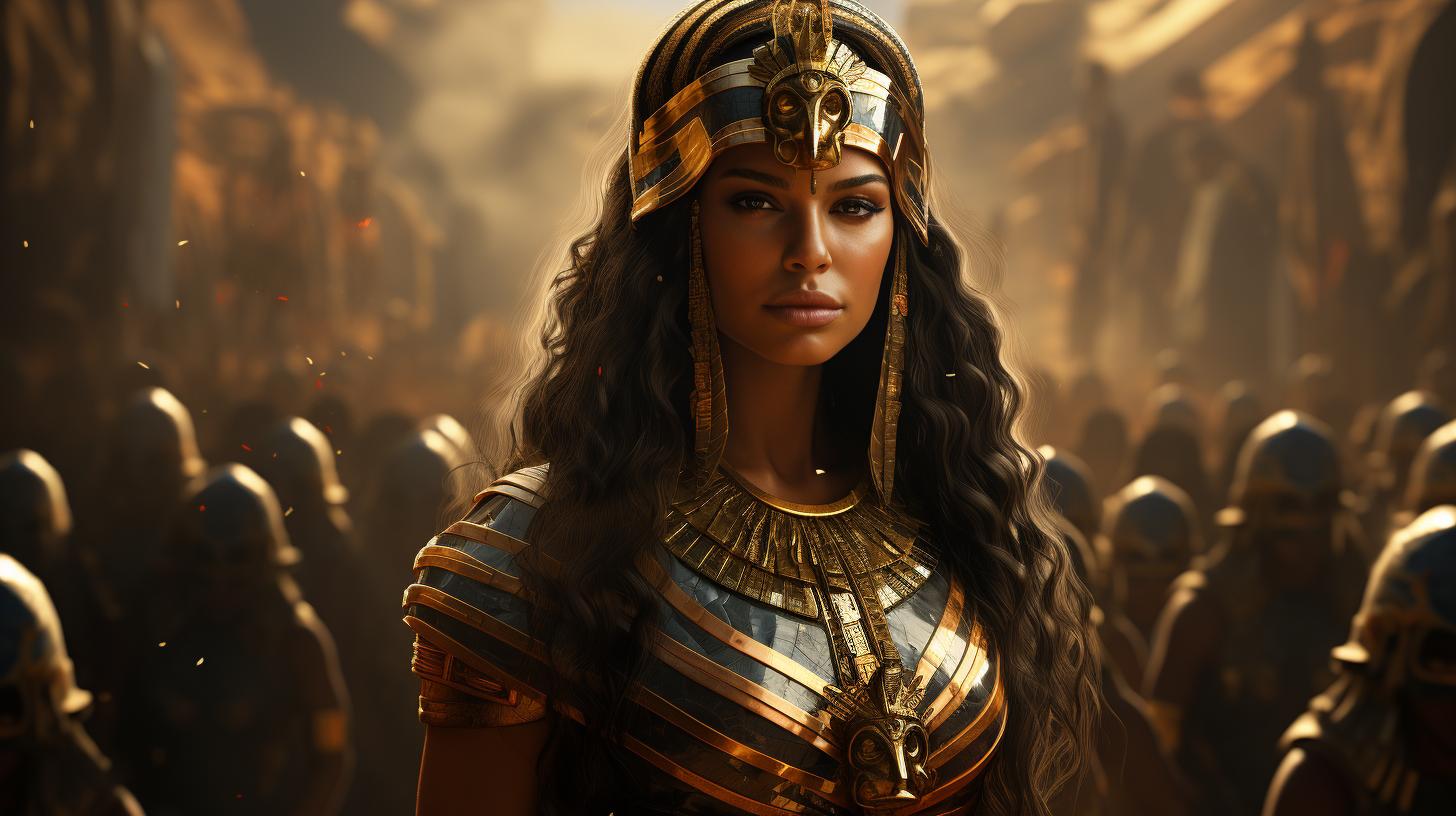The 10 Plagues and Egyptian Gods: Unveiling the Divine Power of Jehovah
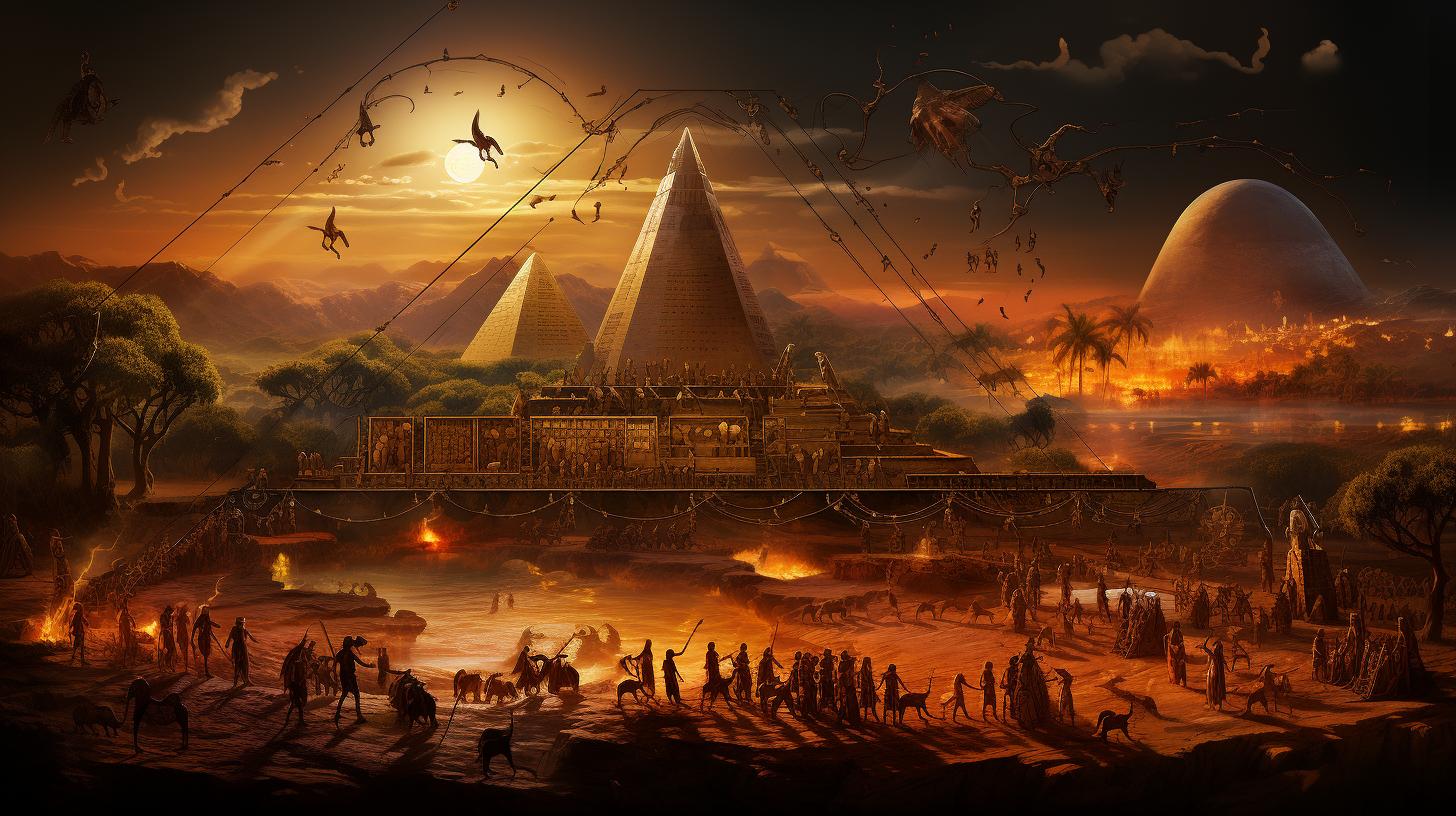
The 10 Plagues and Egyptian Gods are a significant aspect of ancient history. These ten calamities, described in the book of Exodus, were a demonstration of Jehovah’s power over the Egyptian deities.
Each plague targeted a specific god and served a purpose, showcasing God’s supremacy and ultimately leading to the liberation of the Israelites from Egyptian slavery. This article seeks to delve into the historical background, explore the theological implications, and analyze the cultural legacy of these remarkable events.
Let us unravel the intricate connection between the 10 Plagues and Egyptian Gods.
The Historical Background of the 10 Plagues in Egypt
The 10 Plagues in Egypt, as described in the biblical book of Exodus, mark a significant period in ancient history. These catastrophic events unfolded during the reign of Pharaoh Ramses II, also known as Ramses the Great, around the 13th century BC.
The Israelites, who had been enslaved in Egypt for generations, sought their freedom under the leadership of Moses and his brother Aaron.
These plagues were not random natural disasters, but deliberate acts of divine intervention by the God of Israel, Jehovah, to demonstrate his power and demand the release of his people.
Each plague targeted a specific deity of the Egyptian pantheon, challenging the authority and efficacy of these gods.
These extraordinary plagues included turning the Nile River into blood, swarms of frogs, infestations of lice, swarms of flies or wild animals, the death of livestock, outbreaks of boils and sores, hailstorm and fire, plague of locusts, darkness covering Egypt, and the death of the firstborn.
The historical background of the 10 Plagues helps us understand the context in which these events occurred and their significance in relation to the Egyptian culture and religious beliefs of the time.
Studying this historical backdrop not only sheds light on the biblical account but also provides insights into the profound impact these plagues had on Egyptian society and their eventual liberation from slavery.
Understanding the Egyptian Gods and their Significance
In order to comprehend the profound impact of the 10 Plagues on Egypt, it is crucial to grasp the significance of the Egyptian gods worshiped during that time. These deities played a central role in the daily lives and beliefs of the ancient Egyptians, influencing various aspects of their society, from agriculture to fertility.
- The Role of Hapi and Osiris
- The Beliefs Surrounding Heket, the Goddess of Fertility
- The Significance of Seb, the God of the Earth
- The Duality of Hathor and Vatchi: Protection and Flies
- Understanding Apis, the God of the Bull
- The Worship of Sekhmet, the Goddess of Epidemics
- Exploring Nut, Seth, and Shu: Gods of the Sky and Atmosphere
- The Influence of Siris and Serapia on Egyptian Agriculture
- Ra, the Dominant Diety: Symbolism of the Sun
- Heget and Min: Deities of Birth and Reproduction
By comprehending the roles and significance of these Egyptian gods, we can better understand the nature of the 10 Plagues and their direct challenges to these deities.
This knowledge unveils the divine power of Jehovah and the ultimate purpose behind each plague, liberating the Israelites from Egyptian bondage.
The First Plague: Turning the Nile into Blood
The first of the ten devastating plagues that befell Egypt was the transformation of the Nile River into blood. This cataclysmic event had a profound impact on Egyptian society, as it directly targeted the god Hapi, who was associated with the annual flooding of the river.
The Nile, revered as the lifeblood of the nation, was now transformed into a symbol of death and desolation.
As the waters turned crimson, the once-vibrant ecosystem teeming with fish and sustaining agriculture collapsed.
This plague demonstrated the power of Jehovah, showcasing His control over nature and His dominion over even the most revered deities. It was a direct challenge to the authority of Hapi and the Egyptian pantheon.
The transformation of the Nile into blood caused widespread devastation, disrupting daily life, and further deteriorating the already strained relationship between the Hebrew slaves and their Egyptian captors. It was a clear message that Jehovah was the one true God, asserting His sovereignty over the false gods of Egypt.
This unparalleled demonstration of divine power marked the beginning of a series of calamities that would ultimately lead to the liberation of the Israelites from their oppressive bondage in Egypt.
The Second Plague: Invasion of Frogs
The second plague unleashed upon Egypt was a relentless invasion of frogs.
These amphibious creatures multiplied rapidly, crawling out of the Nile River and infesting every corner of the land. The Egyptians found themselves surrounded by the croaking and hopping creatures, disrupting their daily lives and causing immense discomfort.
This plague targeted the Egyptian gods Hapi, associated with the prosperity of the Nile, and Heket, the goddess of fertility who had a frog-like appearance. By inundating Egypt with frogs, Jehovah demonstrated his power over these deities and undermined their control over the natural world.
The presence of frogs in every aspect of Egyptian life, from their homes to their food, was a reminder of the impotence of their gods. This divine intervention conveyed that Jehovah, the God of Israel, reigned supreme and possessed authority over all creation.
The invasion of frogs not only symbolized the downfall of these specific deities but also conveyed a broader theological message. It revealed the futility of worshipping false gods and highlighted the need to acknowledge and serve the one true God.
The plague of frogs was a pivotal moment in the series of divine judgments against Egypt, intensifying the pressure on Pharaoh to release the Israelites. It served as a powerful manifestation of Jehovah’s sovereignty, igniting fear among the Egyptians and paving the way for the subsequent plagues to come.
The Third Plague: Infestation of Lice
The third plague unleashed upon the Egyptians was a dreadful infestation of lice. These tiny insects swarmed upon both humans and animals, causing intense discomfort and irritation. The plague targeted the Egyptian god Seb, who was considered the god of the earth.
The infestation of lice served as a powerful demonstration of Jehovah’s authority over the so-called gods of Egypt.
With this divine intervention, Jehovah showcased his power to control even the smallest creatures and demonstrated his ability to disrupt the daily lives of the Egyptians. The infestation of lice served as a clear message to Pharaoh and his people, revealing the futility of their trust in the Egyptian gods.
It brought them face to face with the reality of Jehovah’s ultimate authority.
The impact of this plague was significant, as it added to the escalating misery of the Egyptian population. The inability of their own gods to prevent or alleviate such suffering shattered the Egyptian beliefs in the invincibility of their pantheon.
Ultimately, the infestation of lice played a vital role in weakening Pharaoh’s resolve and setting the stage for the subsequent plagues that would follow.
The infestation of lice stands as a profound testament to Jehovah’s unwavering power, leaving no doubt about his supremacy over all creation. It marked yet another step in the relentless march toward the deliverance of the Israelites and the fulfillment of God’s promises.
The Fourth Plague: Swarms of Flies or Wild Animals
In this devastating plague, swarms of flies or wild animals infested Egypt, causing immense discomfort and chaos. The land was overrun by these pests, making daily life unbearable for the Egyptians.
The plague of flies or wild animals was a direct judgment on the Egyptian gods Hathor and Vatchi. Hathor, associated with protection, failed in her divine duty to shield the people from this affliction, while Vatchi, the god of flies, was unable to prevent their overwhelming presence.
The swarms of flies or wild animals served as a powerful demonstration of Jehovah’s authority and control over nature. By unleashing this plague, God showcased his ability to manipulate creation and assert his dominance over the false gods of Egypt.
This divine intervention left the Egyptians grappling with the consequences of their stubbornness and refusal to acknowledge Jehovah’s supremacy.
The Fourth Plague not only brought further suffering to the Egyptians but also reinforced the underlying message of God’s power and determination to free his chosen people from bondage.
By contrasting his might against the impotence of the Egyptian deities, Jehovah made it clear that he alone possessed the ability to bring both punishment and deliverance.
As the plagues unfolded, each event left an indelible mark on Egyptian society, challenging their religious beliefs and highlighting the futility of worshipping mere idols.
The Fourth Plague, with its swarms of flies or wild animals, further eroded the confidence of the Egyptians in their pantheon of gods, paving the way for the eventual liberation of the Israelites from their enslavement.
The Fifth Plague: Death of Livestock
The fifth plague unleashed by Jehovah upon Egypt was a devastating blow to their agricultural and economic systems. In this plague, all the livestock belonging to the Egyptians perished. Cattle, goats, sheep, and other domesticated animals died in large numbers, causing significant loss and destruction.
By targeting the Egyptian god Apis, who was symbolized as a sacred bull, Jehovah demonstrated His supremacy over their deities. The death of the livestock not only affected the livelihoods of the Egyptians but also undermined their belief in the power of their gods to protect them.
The decimation of the livestock had severe consequences for agriculture, as these animals were crucial for farming, transportation, and food production. It further weakened an already shaken Egypt, exacerbating the impact of previous plagues and adding to the mounting despair among the population.
This plague served as a clear sign of God’s judgment and power, displaying His authority over Egypt’s gods and emphasizing the futility of worshiping false deities. It also foreshadowed the devastating blow that would soon come during the final plague, leading ultimately to the liberation of the Israelites from their bondage.
The Sixth Plague: Outbreak of Boils and Sores
The sixth plague brought immense suffering and affliction to the people of Egypt as they were plagued with painful boils and sores. This devastating outbreak targeted both humans and animals, demonstrating the relentless power of God’s judgment.
The boils and sores were not merely physical afflictions, but a divine proclamation against Sekhmet, the Egyptian goddess of epidemics. The severity of the plague highlighted the futility of relying on false gods for protection and healing.
This plague served as a powerful demonstration of Jehovah’s supremacy over the gods of Egypt. It exposed the inability of the Egyptian pantheon to protect or provide relief during times of crisis.
The Egyptians witnessed firsthand the destructive consequences of their idolatry and the unfailing authority of the God of Israel.
The outbreak of boils and sores further intensified the pressure on Pharaoh, compelling him to reconsider his obstinacy.
However, despite the escalating afflictions, Pharaoh’s heart remained hardened, refusing to release the Israelites from their bondage.
The sixth plague serves as a stark reminder for us today to seek refuge in the one true God, who alone can bring healing, redemption, and deliverance.
It calls us to reflect on the consequences of worshiping false idols and to acknowledge the sovereignty of Jehovah.
The Seventh Plague: Hailstorm and Fire
The seventh plague unleashed upon Egypt was a devastating hailstorm accompanied by fire. This catastrophic event brought destruction to crops, possessions, and even claimed lives. The hailstones, larger than any seen before, pummeled the land, ravaging everything in their path.
With this plague, Jehovah targeted the Egyptian gods associated with the sky, storms, and atmosphere. Nut, Seth, and Shu were among the deities challenged by the divine power of Jehovah.
The hailstorm and fire symbolized God’s control over the natural elements worshipped by the Egyptians.
Pharaoh, once again, witnessed the awesome power of Jehovah and sought relief from the increasing devastation.
Realizing the futility of his resistance, he promised to let the Israelites go, only to retract his decision once the plague subsided.
The seventh plague served as a turning point, emphasizing God’s dominion over the gods of ancient Egypt.
It demonstrated the consequences of defying Jehovah’s commands and the futility of relying on false deities.
As we delve into the account of the seventh plague, we uncover deeper theological implications and gain profound insights into the nature of God’s intervention on behalf of His people.
It remains a testament to the faithfulness and power of Jehovah, leaving a lasting legacy in both biblical and Egyptian history.
The Eighth Plague: Plague of Locusts
The eighth plague unleashed upon Egypt was the devastating swarm of locusts, wreaking havoc on the remaining crops and vegetation. These voracious insects descended upon the land, devouring everything in their path, leaving behind utter desolation.
The arrival of the locusts symbolized a divine judgment on the Egyptian god Serapia, associated with agriculture and fertility. This plague served as a concrete demonstration of Jehovah’s supremacy over the gods of nature, emphasizing His power to bring about both destruction and restoration.
The sheer magnitude of the locust invasion was overwhelming, as they darkened the sky and caused darkness to engulf Egypt. The relentless swarm obliterated any hope of agricultural recovery, plunging the nation into further hardship and despair.
Pharaoh, witnessing the devastation caused by the locusts, conceded momentarily, only to retract his promise of releasing the Israelites once the insects dissipated. This obstinate resistance further showcased Pharaoh’s refusal to acknowledge Jehovah’s authority and serve as a catalyst for the next plagues that would befall Egypt.
The Eighth Plague, with its far-reaching consequences, exemplified the relentlessness of God’s judgment and reaffirmed His determination to free His people from bondage. It serves as a reminder of the consequences of disobedience and the enduring power of divine retribution.
The Ninth Plague: Darkness Covers Egypt
As the ninth plague descended upon Egypt, an impenetrable darkness shrouded the land for three long days. In this eerie darkness, the Egyptians were rendered helpless, unable to see, move, or carry out their daily activities.
This plague directly challenged the authority of Ra, the sun god, revealing the absolute power of Jehovah over the Egyptian deities. The darkness was not just a physical absence of light but symbolized the spiritual blindness and ignorance that had engulfed the Egyptians.
It served as a stark reminder of their refusal to acknowledge the true God and their unwavering loyalty to their false gods.
The Israelites, however, experienced light in their dwellings, a clear demonstration of God’s favor and protection upon His chosen people.
It was a profound manifestation of God’s guidance and provision, even in the midst of chaos and despair.
The darkness that blanketed Egypt during this plague carried a significant message: allegiance to false gods leads to spiritual darkness, while trust in the one true God brings forth spiritual illumination and understanding.
This plague marks a pivotal moment in the struggle between Jehovah and the Egyptian pantheon, highlighting God’s sovereignty and His purpose of setting His people free from the clutches of slavery.
The Tenth Plague: Death of the Firstborn
The tenth and final plague unleashed upon Egypt was the most devastating of them all—the death of the firstborn. In this unfathomable tragedy, every firstborn child in Egypt, from the highest of nobility to the lowliest servant, perished in a single night.
Only the Israelites, marked with the blood of the Passover lamb, were spared from this horrific judgment.
Pharaoh’s obstinacy in refusing to release the Israelites led to this catastrophic event. It not only brought immense grief and sorrow to every family in Egypt but also shattered the foundation of their social order.
This plague struck at the core of their belief system, as the firstborns held significant importance in Egyptian religion and succession.
The magnitude of this devastation finally convinced Pharaoh to relent, and he begrudgingly allowed the Israelites to leave Egypt.
The power and sovereignty of God soared above all earthly rulers, as He displayed His authority over life and death.
Reflecting on the profound implications of the tenth plague, we witness the divine justice and judgment upon the oppressors.
It stands as a reminder of God’s faithfulness in fulfilling His promises and His unrelenting defense of His people. Moreover, it foreshadows the ultimate sacrifice of Christ, the Lamb of God, who would save humanity from eternal death.
Analysis of the Biblical Account of the Plagues
The biblical account of the ten plagues in Egypt provides a fascinating glimpse into the supernatural judgment unleashed by Jehovah upon the gods of Egypt. Each plague was carefully designed to challenge a specific deity, demonstrating both Jehovah’s superiority and the futility of Egyptian idol worship.
Through a series of miraculous events, Jehovah systematically undermined Egypt’s religious system and showcased His unrivaled power.
Examining these plagues reveals a pattern of escalating intensity, as each subsequent plague intensified the suffering and devastation experienced by the Egyptians.
The plagues targeted crucial aspects of Egyptian life, such as the Nile River, livestock, and even the health of the people. These afflictions drove home the message that Jehovah was in control, and the Egyptian gods were impotent in the face of His majesty.
Furthermore, the plagues were both acts of divine justice and strategic deliverance for the Israelites. By subjecting the Egyptians to the same hardships they had inflicted upon the Israelites, Jehovah demonstrated His righteous judgment and unleashed a powerful message of liberation.
Through this series of miraculous interventions, Jehovah accomplished His objective of freeing His people from their bondage and solidifying His reputation as the one true God.
The analysis of the biblical account of the plagues provides profound insights into the power, sovereignty, and redemptive purposes of Jehovah.
It underscores the divine intervention that redefined the course of history and serves as a testament to the enduring significance of these events in shaping religious beliefs and cultural narratives.
The Theological Significance of the Plagues
The plagues that befell Egypt hold profound theological implications.
They reveal God’s sovereignty and power over the false gods worshipped in Egypt, emphasizing His role as the one true God. Each plague specifically targeted a different Egyptian deity, dismantling their supposed authority and exposing their insignificance in comparison to the Almighty.
Furthermore, the plagues showcased God’s judgment and justice against the idolatrous practices of the Egyptians. By demonstrating His control over natural elements and life itself, God demonstrated that He alone deserved worship and obedience.
The plagues served as a warning to both the Egyptians and the Israelites, reminding them of the consequences of disobedience and faithlessness.
Moreover, the plagues were not mere acts of destruction, but intentional displays of God’s mercy and redemption.
Through these extraordinary events, God provided an opportunity for Pharaoh and Egypt to acknowledge His supremacy and repent. The plagues revealed God’s desire for His people’s freedom and demonstrated His unfailing commitment to deliver them.
Overall, the theological significance of the plagues lies in their affirmation of God’s authority, justice, and redemption. They highlight His unmatched power and reveal His unwavering faithfulness to His people, ultimately laying the groundwork for the liberation of the Israelites and solidifying their faith in the one true God.
Comparisons with Other Ancient Plagues and Gods
When examining the ten plagues sent upon Egypt, it is intriguing to consider their connections and potential similarities to other ancient plagues and gods. While each plague in the Exodus narrative held its own significance and purpose, there are parallel occurrences in other ancient cultures that bear resemblance to some of these calamities.
For example, the concept of turning water into blood, as seen in the first plague, has similarities to the Sumerian goddess Nanshe, associated with the purification of water. Similarly, the outbreak of flies or wild animals in the fourth plague has parallels in Mesopotamian and Greco-Roman mythology.
Additionally, the death of livestock, the hailstorm and fire, and the plague of locusts can find similar occurrences in various cultures throughout history. These comparisons shed light on the shared fears and beliefs surrounding natural disasters and their link to divine intervention.
While the specific connection between the Egyptian plagues and other ancient calamities may be subject to interpretation and further research, it is undeniable that these events echo a universal understanding of the power and influence of divine entities in shaping the course of human history.
- Similarities with other ancient plagues and gods:
- – Turning water into blood
- – Outbreak of flies or wild animals
- – Death of livestock
- – Hailstorm and fire
- – Plague of locusts
These comparative observations enhance our comprehension of the cultural significance of the ten plagues and highlight the interconnectedness of ancient beliefs and phenomena across different civilizations.
The Impact of the Plagues on Egyptian Society and Beliefs
The ten plagues had a profound impact on the society and beliefs of ancient Egypt. These calamities, specifically targeted at Egyptian gods, shook the confidence of the people and challenged their religious framework.
1. Shattered Faith: The plagues exposed the inability of the Egyptian gods to protect their worshippers. The failure of Hapi, Osiris, Heket, and other deities to prevent or mitigate the disasters led to doubts and skepticism among Egyptians.
2. Social Disruption: Each plague disrupted daily life, causing chaos and misery. The inundation of frogs, the infestation of lice, the death of livestock, and other calamities affected basic necessities, livelihoods, and social order.
3. Economic Devastation: The plagues brought severe economic consequences. The destruction of crops, the loss of livestock, and the devastation caused by hail and locusts crippled the agricultural and economic backbone of Egypt.
4. Political Instability: Pharaoh’s stubbornness and refusal to heed the warnings of Moses and Aaron brought political instability. The plagues fueled dissent among the people and weakened Pharaoh’s authority.
5. Psychological Impact: The repeated disasters left the Egyptians traumatized and fearful.
The relentless onslaught of divine judgments instilled a sense of dread and powerlessness among the populace.
6. Reevaluation of Beliefs: The plagues prompted Egyptians to reevaluate their religious beliefs. Some Egyptians may have questioned the efficacy of their deities while others may have sought answers and turned to alternative spiritual paths.
The impact of the plagues on Egyptian society and beliefs was far-reaching, disrupting all aspects of life and reshaping the religious landscape. Marks of these events can still be seen in the historical and cultural legacy of ancient Egypt.
The Cultural and Historical Legacy of the Plagues
The ten plagues that ravaged Egypt and brought about the liberation of the Israelites under the leadership of Moses have left a profound impact on both culture and history. The natural disasters and divine interventions witnessed during this period continue to capture the imagination of people across generations.
From an archaeological standpoint, the plagues have stimulated extensive research into the historical accuracy of the biblical account. Scholars have debated the scientific plausibility of each plague, exploring potential explanations rooted in natural phenomena.
These investigations contribute to our understanding of ancient Egypt’s agricultural practices, environment, and socio-political dynamics.
Moreover, the plagues played a significant role in shaping Egyptian mythology and religious beliefs. The catastrophic events challenged the power and authority of their gods, raising questions about their ability to protect and govern.
This crisis of faith prompted theological discourse and reformulations within the Egyptian pantheon.
The legacy of the plagues extends beyond Egypt to influence diverse cultural mediums. The story has been depicted in literature, art, and film, emphasizing its timeless appeal.
It serves as a cautionary tale against oppression and a symbol of divine justice prevailing over the forces of tyranny.
- Archaeological investigations into the plagues
- Theological repercussions and reformulation of Egyptian beliefs
- The plagues as a source of inspiration in various forms of cultural expression
Exploring Different Interpretations of the Plagues
As we delve into the recounting of the 10 Plagues, it becomes apparent that various interpretations and theories exist regarding their nature and significance.
Scholars and theologians offer different perspectives that shed light on the events and their intended meanings. Here are some of the different interpretations:
- Symbolic and metaphorical: Some interpret the Plagues as symbolic representations of natural disasters or socio-political upheavals, reflecting the consequences of Pharaoh’s hardened heart.
- Divine judgment: Another viewpoint considers the Plagues as direct judgments from God on Egypt and its gods for their mistreatment of the Israelites.
- Historical natural phenomena: Certain scholars propose that the Plagues were extraordinary yet natural events, magnified by the collective memory and religious context of ancient Egypt.
- Strategic attacks: Some theories suggest that Moses and Aaron strategically chose specific plagues that targeted the Egyptian gods to undermine their authority and demonstrate the power of the Israelite God.
- Psychological warfare: Another interpretation posits that the psychological impact of the Plagues played a significant role in breaking Pharaoh’s resistance and leading to the Israelites’ release.
By exploring these diverse interpretations, we gain a deeper understanding of the complex nature of the Plagues and the profound theological and historical implications they hold.
These various perspectives contribute to the ongoing dialogue surrounding the significance and purpose of the Plagues in the overall narrative of the Exodus.
Common Misconceptions and Debunking Myths about the Plagues
As we delve deeper into the fascinating account of the 10 Plagues and Egyptian Gods, it is essential to address some common misconceptions and debunk prevailing myths surrounding these extraordinary events.
By shedding light on the truth, we can better understand the significance of the plagues and their role in the liberation of the Israelites.
- Myth 1: The plagues were mere coincidence or natural disasters.
- Myth 2: The purpose of the plagues was to punish innocent Egyptians.
- Myth 3: The plagues were isolated occurrences unrelated to each other.
- Myth 4: The plagues were the result of ancient Egyptian’s negligence.
- Myth 5: The plagues were merely symbolic and not actual events.
Contrary to these misconceptions, the biblical account portrays the plagues as supernatural phenomena orchestrated by Jehovah to demonstrate His power and sovereignty over the Egyptian gods.
Each plague was purposefully crafted, delivering precise messages and judgments. Moreover, the plagues can be understood within the larger context of the Exodus story, where God relentlessly pursued the liberation of His people.
By dispelling these myths, we can appreciate the profound theological and historical significance of the plagues and comprehend their enduring impact on both ancient Egypt and the Israelite nation.
Lessons and Insights from the Plagues in Modern Context
The plagues that occurred in ancient Egypt hold valuable lessons and insights even in our modern context.
They serve as a stark reminder of the consequences of oppressing and mistreating others. Here are some key takeaways:
- Respect for human dignity: The plagues highlight the importance of treating all individuals with dignity and respect, regardless of their background or social status.
- The power of unity: The Israelites’ liberation was a result of their unity and collective action.
It reminds us that working together for a common cause can lead to positive change.
- Environmental responsibility: The ecological impact of the plagues is a reminder of our responsibility to care for and protect the natural world.
- Power of faith and perseverance: The Israelites’ unwavering faith in Jehovah and their perseverance during challenging times demonstrate the strength that can be found in faith.
- Consequences of oppressive leadership: The plagues serve as a warning against oppressive leadership and the harm it can cause to both the oppressors and the oppressed.
By reflecting on these lessons and insights, we can apply them to our own lives and work towards creating a more just and compassionate society, free from oppression and injustice.
The Plagues and their Connection to the Exodus Story
The ten plagues unleashed upon Egypt hold a crucial significance in the larger narrative of the Exodus. They serve as a catalyst for the eventual liberation of the Israelites from their bondage.
Each plague, targeting a specific aspect of Egyptian life, challenged the authority of the Egyptian gods and showcased the supremacy of Jehovah.
As the plagues unfolded, Pharaoh’s resolve weakened, eventually leading to the pivotal moment of the tenth plague—the death of the firstborn.
This devastating event became the breaking point, forcing Pharaoh to release the Israelites from their enslavement.
The plagues not only demonstrated God’s power over the Egyptian gods but also highlighted His faithfulness to His promises made to His people.
It’s crucial to understand that these plagues were not random acts of destruction but purposeful judgments orchestrated by Jehovah to assert His authority and fulfill His divine plan.
The connection between the plagues and the Exodus story is symbiotic—each plague tested Pharaoh’s heart and resolve while solidifying the Israelites’ faith in their redeeming God.
This chapter of history stands as a testament to God’s intervention and His relentless pursuit of liberation for His chosen people.
In the following sections, we will delve deeper into the theological implications, historical legacy, and cultural impact of the ten plagues, providing a comprehensive understanding of their significance in the Exodus narrative.
Examining God’s Intervention and Power in the Plagues
As we delve deeper into the extraordinary events of the 10 Plagues, one cannot help but be astounded by the intervention and power displayed by God. Each plague was meticulously orchestrated to demonstrate not only the futility of Egyptian gods but also the omnipotence of Jehovah.
Through turning the Nile into blood, sending forth swarms of frogs, and infesting Egypt with lice and flies, God proved His authority over the deities associated with water, fertility, and protection.
Moreover, the death of livestock, the outbreak of boils and sores, and the onslaught of hail and locusts showcased God’s supremacy over divine entities related to agriculture, health, and natural disasters.
When darkness enveloped Egypt for three days, it was a stark reminder of God’s dominion over the sun, the epitome of Egyptian worship. Finally, as the disastrous climax, the death of the firstborn struck at the very heart of Egyptian society, targeting the gods of childbirth and reproduction.
The plagues testify to God’s absolute control over creation, defying all earthly forces. Such demonstrations of divine intervention not only shattered the illusions of Egypt but also underscored the significance of the Exodus story and the subsequent liberation of the Israelites.
By examining the intricate details of each plague, we gain a deeper understanding of God’s continuous involvement, His profound judgment, and His unwavering commitment to His people. These events serve as a lasting testament to God’s supreme power and provide profound lessons for us to reflect upon even in the present day.
Exploring the Role of Moses and Aaron in the Plagues
Moses and Aaron played crucial roles in the narrative of the 10 Plagues and Egyptian Gods. As God’s chosen messengers, they were instrumental in delivering God’s divine judgments upon the Egyptian people.
Moses, with Aaron as his spokesperson, approached Pharaoh on multiple occasions, demanding the release of the Israelites and warning of the impending plagues if he refused.
Throughout the plagues, Moses and Aaron acted as intermediaries between God and Pharaoh, conveying God’s instructions and performing the miraculous signs that accompanied each plague.
Their unwavering faith and obedience to God’s commands allowed them to confront Pharaoh’s resistance and demonstrate the consequences of his pride.
Moses, in particular, emerged as a prophetic figure, demonstrating his intimate connection with God and his ability to communicate God’s will.
His leadership and unwavering trust in God’s plan guided the Israelites through the grueling ordeal of the plagues, leading them closer to their ultimate freedom.
Aaron, as Moses’ brother and assistant, supported him in carrying out the miraculous signs and communicating God’s message.
Together, they confronted the Egyptian magicians, revealing the superiority of God’s power over the supposed magic of the Egyptian gods.
In summary, Moses and Aaron were pivotal figures in the narrative of the 10 Plagues and Egyptian Gods.
Their obedience to God’s commands, prophetic role, and unwavering leadership were essential in bringing about the liberation of the Israelites and showcasing the power and authority of God over the false deities of Egypt.
The Aftermath of the Plagues: Pharaoh’s Response and Exodus
After enduring the devastating ten plagues that ravaged Egypt, Pharaoh’s response and the subsequent Exodus of the Israelites marked a crucial turning point in the biblical narrative. Pharaoh’s heart remained hardened, and he initially refused to release the Israelites, despite the catastrophic consequences that befell his land.
However, the death of the firstborn in every Egyptian household during the tenth plague finally broke Pharaoh’s resolve. Overwhelmed by grief and fear, he relented and granted the Israelites permission to leave Egypt.
The Israelites wasted no time and began their journey towards the Promised Land under the leadership of Moses and Aaron.
The aftermath of the plagues echoed throughout Egypt, leading to a sense of loss and devastation among the Egyptian people.
The once-proud nation, known for its mighty gods, now witnessed firsthand the power of the God of Israel. The plagues left an indelible mark on Egyptian society, shattering their beliefs and questioning the authority of their deities.
The Exodus of the Israelites from Egypt not only marked their physical liberation but also signified the fulfillment of God’s promises and his faithfulness to his chosen people. It demonstrated the supernatural intervention of God in human affairs and showcased his unrivaled power over the gods of Egypt.
This pivotal event laid the foundation for the Israelites’ journey to the Promised Land and further reinforced their belief in the God of Israel as the one true God. The narrative of the plagues and the subsequent Exodus continues to resonate with Christians today, serving as a reminder of God’s deliverance and faithfulness.
Understanding the Journey to the Promised Land
The journey to the Promised Land was a pivotal part of the Israelites’ liberation from slavery in Egypt. After the tenth plague, Pharaoh finally allowed them to leave, and they embarked on a long and arduous journey.
Led by Moses and Aaron, the Israelites had to navigate through various challenges and obstacles.
As they left Egypt, they faced the daunting task of crossing the Red Sea, which miraculously parted to allow them safe passage.
This event solidified their trust in God’s protection and guidance. However, their journey was far from easy. They wandered through the wilderness for forty years, relying on divine provisions for sustenance and guidance.
The journey to the Promised Land was not just physical; it was also a spiritual and emotional transformation. The Israelites had to learn to let go of their slave mentality and embrace their identity as a chosen people.
They had to overcome doubt, rebellion, and the allure of idolatry.
Ultimately, the journey to the Promised Land symbolizes the process of deliverance and transformation. It represents the trials and tests that one must endure to reach a place of fulfillment and prosperity.
It serves as a powerful reminder that the road to freedom is not always straightforward, but with faith, perseverance, and reliance on God, one can overcome any challenge and find their promised land.
Theological Implications of the Plagues for Christians Today
For Christians today, the ten plagues in Egypt hold significant theological implications that resonate with their faith. These ancient events highlight God’s divine power, faithfulness, and his desire to deliver his people from bondage.
First and foremost, the plagues demonstrate God’s sovereignty over all creation. They serve as a reminder that no matter the challenges or trials believers may face, God has ultimate control over every circumstance.
It reassures Christians of his ability to intervene in their lives and bring about deliverance.
The plagues also underscore the importance of obedience and trust in God. Just as the Israelites were instructed to follow specific instructions, Christians today are called to trust in God’s guidance and follow his commandments.
The consequences of disobedience, as seen in the fate of the Egyptians, serve as a cautionary reminder of the dangers of straying from God’s will.
Another significant implication is the revelation of God’s character.
Through the plagues, Christians witness his compassion for his people and his desire for justice. They learn that God is not only a God of love but also a God of righteousness who will hold the oppressors accountable and vindicate the oppressed.
Furthermore, the plagues foreshadow the ultimate redemptive act of God through Jesus Christ. As Christians reflect on the deliverance of the Israelites from Egypt, they find parallels in their own redemption through the sacrifice of Jesus.
The blood of the Passover lamb that saved the Israelites from death finds its ultimate fulfillment in the blood of Jesus, their eternal Passover Lamb.
In conclusion, the ten plagues in Egypt carry profound theological implications for Christians today.
They illustrate God’s sovereignty, the importance of obedience and trust, and reveal aspects of his character. Moreover, they point to the ultimate redemption found in Jesus Christ. Reflecting on these ancient events strengthens the faith of believers, assuring them of God’s power and faithfulness in their own lives.
Resources and Further Studies on the 10 Plagues and Egyptian Gods
For those who want to delve deeper into the fascinating subject of the 10 Plagues and Egyptian Gods, there are various resources and further studies available. These sources provide insight into the historical, theological, and cultural aspects surrounding this significant event in biblical history.
Here are some recommended resources:
- Books: Consult renowned authors such as William H. Propp, who provides a critical analysis of the Exodus narrative in “Exodus 1-18” or Jan Assmann’s “Moses the Egyptian,” exploring the cultural and religious context of ancient Egypt.
- Academic Journals: Access scholarly articles in journals like the Journal of Ancient Egyptian Interconnections or the Journal of Near Eastern Studies, which offer in-depth research on the plagues, Egyptian gods, and their connections.
- Archaeological Studies: Explore archaeological findings related to ancient Egypt and the Exodus story through publications by renowned organizations like the Egypt Exploration Society, offering a wealth of information and insights.
- Online Courses and Lectures: Enroll in online courses or watch lectures from universities, such as Yale University’s “Introduction to the Old Testament” or Harvard University’s “Religions of the Ancient Mediterranean,” which cover the plagues and their religious significance.
- Documentaries and Films: Watch documentaries like “The Exodus Decoded” or feature films like “The Ten Commandments” to gain a visual understanding of the plagues and their impact on ancient Egypt.
These resources provide valuable knowledge and different perspectives on the 10 Plagues and Egyptian Gods, allowing for a comprehensive exploration of this pivotal biblical event.
By studying these materials, one can gain a deeper understanding of the historical context, religious symbolism, and lasting influence of the plagues on ancient Egyptian civilization.
.











